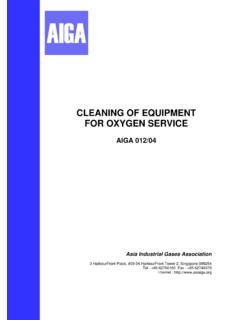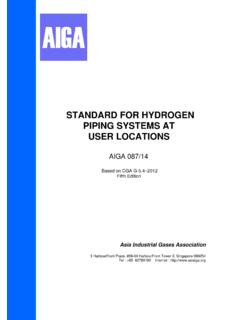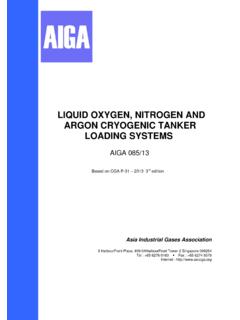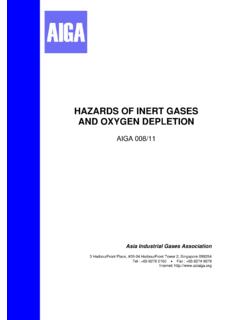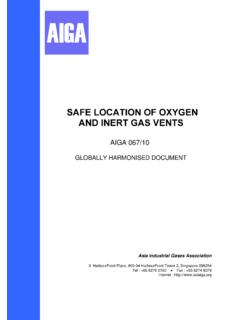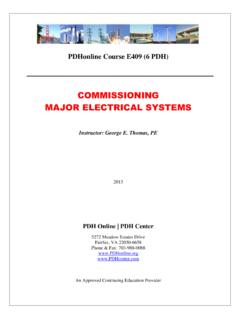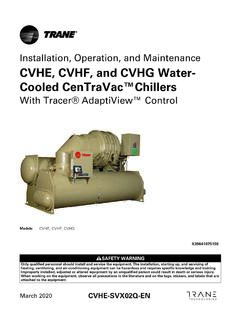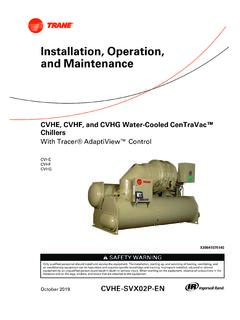Transcription of SAFE STARTUP AND SHUTDOWN PRACTICES FOR STEAM …
1 SAFE STARTUP AND SHUTDOWN PRACTICES FOR STEAM REFORMERS AIGA 086/14 Based on CGA H-11-2013 First Edition Asia Industrial Gases Association 3 HarbourFront Place, #09-04 HarbourFront Tower 2, Singapore 099254 Tel : +65 62760160 Fax : +65 62749379 Internet : with permission from Compressed Gas Association. All rights reserved. ASIA INDUSTRIAL GASES ASSOCIATION 3 HarbourFront Place #09-04 HarbourFront Tower 2 Singapore 099254 Internet: 086/14 SAFE STARTUP AND SHUTDOWN PRACTICES FOR STEAM REFORMERS Disclaimer All publications of AIGA or bearing AIGA s name contain information, including Codes of Practice, safety procedures and other technical information that were obtained from sources believed by AIGA to be reliable and/ or based on technical information and experience currently available from members of AIGA and others at the date of the publication.
2 As such, we do not make any rep-resentation or warranty nor accept any liability as to the accuracy, completeness or correctness of the information contained in these publications. While AIGA recommends that its members refer to or use its publications, such reference to or use thereof by its members or third parties is purely voluntary and not binding. AIGA or its members make no guarantee of the results and assume no liability or responsibility in connection with the reference to or use of information or suggestions contained in AIGA s publications.
3 AIGA has no control whatsoever as regards, performance or non performance, misinterpretation, proper or improper use of any information or suggestions contained in AIGA s publications by any person or entity (including AIGA members) and AIGA expressly disclaims any liability in connection thereto. AIGA s publications are subject to periodic review and users are cautioned to obtain the latest edition. AIGA086/14 PAGE iii Contents Page 1 Introduction and purpose .. 12 Scope .. 23 Definitions .. 24 General considerations .. safety .. response.
4 Safety .. operating procedures .. and Equipment .. furnace inspections .. 75 STARTUP .. preparation .. flow and reformer ignition .. generation and introduction .. introduction considerations .. of downstream units .. of additional fuel streams .. restart after trip .. 146 SHUTDOWN .. SHUTDOWN preparation .. SHUTDOWN procedures (planned SHUTDOWN ) .. SHUTDOWN .. and purging of flammable gas systems in preparation for maintenance .. 187 Training and procedures .. 188 References .. 19 AIGA086/14 PAGE 1 1 Introduction and purpose Introduction As a part of a programme of harmonization of industry standards, the Asia Industrial Gases Association (AIGA) has adopted the Compressed Gas Association (CGA) standard H-11.
5 This international harmonized document is intended for use and application by all IHC member associations. The AIGA edition has the same technical content as the CGA edition, however, there are editorial changes primarily in formatting, units used and spelling. Also, references to regional regulatory requirements have re-placed US regulations where appropriate. Large scale hydrogen production has been commercially practiced for decades and the demand for such pro-duction has grown over that period. In the last several years, developments in crude oil processing, such as the increased use of hydrogen to remove sulfur and the refinement of heavier crude oil stocks, has driven signifi-cant growth in the demand for hydrogen supply.
6 In response to this demand, industrial gas companies operate and maintain large scale hydrogen production facilities worldwide and have done so with an exemplary safety record for many years. However, it should be noted that large scale hydrogen production involves potential personnel and process safety hazards that must be addressed in design and operation. Such hazard potential is inherent to the processing of toxic and flamma-ble gases via high temperature reforming as practiced in hydrogen production. The STEAM reformer represents the core operating unit of most large scale hydrogen production facilities.
7 Therefore, STEAM reformer furnace combustion safety is fundamental to the overall safe operation of these large scale hydrogen plants. The STARTUP and SHUTDOWN of the reformer can create transitional periods of in-creased risk to the operation of the facility. The operating procedures and PRACTICES employed during STARTUP and SHUTDOWN must effectively address the potential hazards of such transitions to ensure plant safety. The need to specifically consider and address the STARTUP and SHUTDOWN of industrial processes is well recog-nized as a cornerstone to safe operation.
8 Requirements to ensure STARTUP and SHUTDOWN safety are addressed in operating procedures and are included in process safety regulations in Title 29 of the Code of Federal Regulations (29 CFR) Part , Process safety management of highly hazardous chemicals, referred to as OSHA Process Safety Management (PSM), and in Europe, Directive 96/82/EC on the control of major-accident hazards (known as the Seveso II Directive), among other regulatory bodies [1, 2]. Guidelines for the safe STARTUP and SHUTDOWN of industrial production units are technology specific.
9 Industry-wide publications addressing STARTUP and SHUTDOWN PRACTICES exist for many technologies, including industry publications such as AIGA 056/08, Safe PRACTICES Guide for Cryogenic Air Separation Plants, which addresses STARTUP and SHUTDOWN of air separation plants [3]. At this time, no such industry-wide guidelines have been compiled and published for STEAM reformer operation. It should be noted that there are other industries, such as ammonia and methanol production, that operate large STEAM reformers.
10 Therefore, it may be instructive to consider the learning and experiences from those industries through organizations such as the American Institute of Chemical Engineering: Ammonia Plant Safe-ty Symposium and the International Methanol Producers and Consumers Association (IMPCA). STEAM reformer furnace design will continue to develop along with methods to implement combustion safety in these furnaces. A wide variety of STEAM reformer designs, configurations, and component equipment exists today. Therefore, this publication includes generalized statements and recommendations on matters which there may be diversity of opinion or practice.
